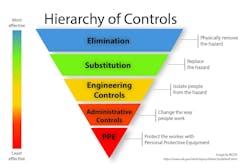Anyone who has worked with large chemical processes for a few years knows that it’s impossible to predict every potential danger, as the universe is very creative when it comes to causing disruptions. Personnel who design large chemical processes or processes involving high amounts of energy have used equations, lab experiments, pilot plants and thought experiments to predict scenarios that may arise during operation. They understand the frustration of processes not working as intended or, worse, failing in an unexpected way.
For many years, engineers relied on this invaluable mechanical design insight and experience, as well as information gathered from end users, to help keep large chemical manufacturing processes safe. Over time, a framework known as the Hierarchy of Controls took shape to provide personnel with guidelines to configure processes and maximize safety. These guidelines have helped manufacturers produce solutions for process safety concerns, such as eliminating dangers, substituting less dangerous options, managing dangers with engineering, implementing safety procedures or providing operators with safety equipment.
Using the Hierarchy of Controls framework (figure 1) with today’s high-fidelity process simulation tools, chemical producers now have even greater insight into their operations. The general value of simulation is its ability to verify the proper order of operations in a control scheme. For example, a simple “tie-back” type simulation, in which the outputs of the control logic are fed to the inputs, can validate that a flow path will be opened before a pump is started (i.e., to confirm that there will be no water hammer). A simple accumulator function can simulate a rising tank level based on the flow rate through a control valve or variable speed pump. These basic approaches can help an operations team avoid hours of troubleshooting during a project start-up and bring the process online faster.
For process safety applications, however, simple approaches cannot provide the level of certainty that large, fast or high-energy chemical processes require when it comes to preventing, detecting and managing dangerous situations. In this instance, a more detailed simulation will reveal unanticipated process behaviors that can drive the control system, the process or both into unstable or uncontrollable regimes. By expanding the simulation to include upstream and downstream processes, it becomes possible to predict unexpected influences that would normally only manifest after commissioning is complete. For a real-world example of a commissioning project, see “Shorten Safety Commissioning Time with Simulation” section below.
Applying High-Fidelity Simulation
The following applications illustrate how chemical producers can benefit from high-fidelity simulation to mitigate risk in their processes:
- Insight into safety protection layers – When combined with other layers of protection, safety instrumented functions (SIF) can protect chemical processes from intolerable hazards and drive process behavior, which may not be obvious from an analysis of the process or control design alone. For example, a shut-off valve for a reactant flow closes at the same instant a pump receives a command to stop from the controller running the SIF. In such cases, the inertia of the motor could lead to a pressurized line. Analyzing SIFs often involves weighing the pros and cons of undesirable situations.
Practical operations personnel would not tolerate having to run through multiple different unsafe scenarios to find the best approach on real-world production equipment. A simulation offers the ability to run scenarios and the various types of corresponding responses, so personnel can determine the best solution during unfavorable situations.
- Take the simulation outside the controller – Higher levels of simulation fidelity require calculations and objects that are beyond those typically available in a programmable logic controller (PLC) or distributed control system (DCS). Many products and services exist to provide more detailed simulations of a process, which can interface with a simulated software controller or a physical controller via Open Platform Communications (OPC). Process modeling software can use OPC to read outputs from and write inputs to the PLC or DCS, and the control logic will never know the difference.
Generally speaking, process-modeling software uses equations from physics to calculate relationships among pressure, temperature, flow and other process variables. Some software exists that supports the simulation of chemical reactions as well, offering the ability to determine reaction rates, heat generation or consumption, phase changes and other properties of interest. Most process-control schemes won’t need that sort of detail, but simulation can reveal important information about a process when it is needed and used properly.
- Effective production operations – Let’s look at a real-world example to understand how simulations can be effective to production operations. Toby McAlister, a senior engineer with Maverick Technologies, a Rockwell Automation company, has experience building his own in-controller simulations, as well as using a third-party, external simulation environment. According to McAlister, the projects where he used a third-party simulation development platform saw enormous time savings as it already had purpose-built tools and objects in it compared to a custom-built, in-controller simulation where he had to first build the simulation tools and objects and then implement them in the controller. An added benefit of using external simulation, he says, is it avoids the requirement to remove or disable logic after the factory acceptance test (FAT). Being able to go to the field with the exact logic that was already tested and accepted is a much more effective and efficient process.
Standards and Simulation
The past decade or so has seen a revolution in standards development for many different types of engineering fields. Without standards, engineers must plan, design and execute their projects from scratch or, at best, use the lessons learned from previous projects as a starting point. Process safety typically involves the IEC 61508 standard, but the time has come to provide personnel with high-fidelity simulation standards to aid in mitigating risk in safety processes and help provide best practices for process simulation.
Process Simulation Training
Training is key to achieving good operational outcomes. The quality of the training is directly related to the quality of the outcome. A new operator or an experienced operator moving to a new role can easily learn how to control normal operation. One common approach is to shadow an experienced operator. But when it comes to hazardous environments and having to deal with uncommon, emergency or dangerous situations, on-the-job training is much less desirable.
Training for emergency or dangerous situations is often a “lessons learned” presentation that perhaps includes some manufacturing execution system data in charts with before-and-after pictures. In training personnel, it’s just not practical for a company to trigger a dangerous event with real equipment to provide the much-needed hands-on experience.
A process simulation training program lets plants train operators in various scenarios without disrupting regular production. Operators at any skill level will benefit by practicing on novel or uncommon operations. When it comes to safely responding to emergencies, the more detailed and frequent the training, the better. During simulation-based training, staff might also uncover ways to improve facility operations.
By using high-fidelity simulation tools, chemical companies can enhance real-world applications and workforce training. This enables accurate prediction and mitigation of chemical safety risks, leading to higher production efficiency, less downtime and improved overall process reliability and safety for both personnel and the environment.
Shorten Safety Commissioning Time with Simulation
A major chemical production facility migrated from a late 20th century distributed control system (DCS) to a modern off-the-shelf DCS. Like most facilities, this chemical plant had very robust but outdated safety systems implemented in the old control system. As a part of the migration to the new DCS, the development team used a high-fidelity process simulation to test the process control. This involved running through the batch process to verify that the migrated system behaved the same as or better than the old system as reflected in MES data.
The testing also involved running through every recipe and – critically – allowed the testing of every safety instrumented function (SIF) multiple times to validate that each one would trigger in response to the criteria established in the safety system design. Most of this was accomplished by a handful of engineers who were able to test the product recipe or safety function, reset the simulation and test the next one. Operations were never interrupted in the real plant during this testing. The operations personnel observed final demonstrations of the new control system running with the simulation during validation testing.
When start-up time came, operations and engineering knew the control system would perform correctly if the instrumentation worked correctly. This allowed the start-up team to focus on validating the instrumentation and its failure modes. Once everything appeared to be working on the instrumentation side, a single demonstration of each SIF was all that was required to get the go-ahead to start production. Without prior testing against a simulation, each SIF would have to be tested multiple times, often requiring exclusive use of the facility, preventing any other work from proceeding.
Additionally, as with all new control systems, there were opportunities for improvement in the process control, recipe system and safety system. Using high-fidelity process simulation, the engineers and operations management were able to identify multiple potential pitfalls and address them before going to the field. This approach prevented bad batches and product loss, saving time, money and frustration for the entire facility.




